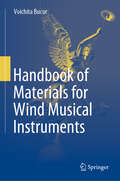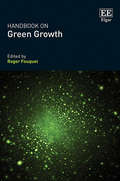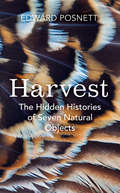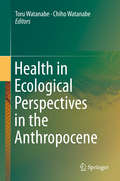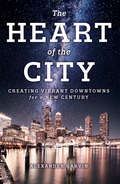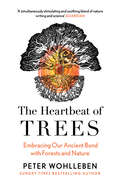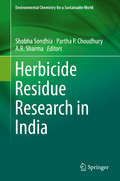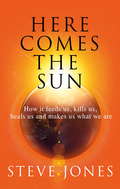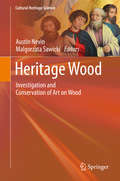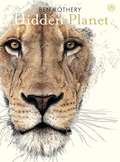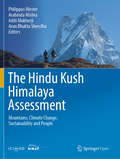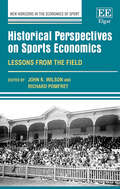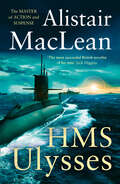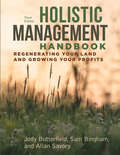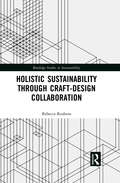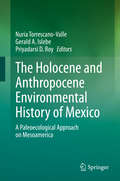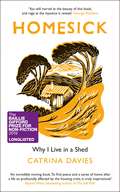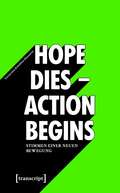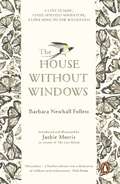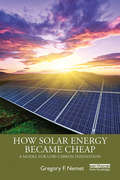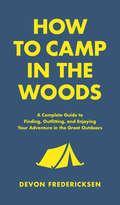- Table View
- List View
Handbook of Materials for Wind Musical Instruments
by Voichita BucurThis book addresses key questions about the materials used for the wind instruments of classical symphony orchestra such as flutes, clarinets, saxophones, oboes, bassoons and pipe organs. The content of this book is structured into four parts.Part 1- Description of materials for wind instruments deals with wood species and materials for reeds used for making clarinet, oboe and bassoon- and, with metallic materials and alloys for - horn, trumpet, trombone, etc. Auxiliary materials associated with the manufacturing of wind instruments are felt, cork, leather and parchment. Part 2- Basic acoustics of wind instruments, in which are presented succinctly, some pertinent aspects related to the physics of the resonant air column. An important aspect discussed is related to the effect of wall material on the vibration modes of the walls of wind instruments. The methods for measuring the acoustical properties of wind instruments are presented. Part 3- Manufacturing of wind instruments, describes the technology used in manufacturing metallic tubes and pipes made of wood. Part 4 - The durability and degradation of materials addresses data about methods for cleaning wind instruments, studies factors producing degradation of organ pipes, describes methods of conservation and restoration of brass instruments and of historical pipe organs. Finally, the properties of marble are described, being the only one nondegradable and sustainable material used for pipes for organs.
Handbook on Green Growth
by Roger FouquetEconomies around the world have arrived at a critical juncture: to continue to grow fuelled by fossil fuels and exacerbate climate change, or to move towards more sustainable, greener, growth. Choosing the latter is shown to help address climate change, as well as present new economic opportunities. This Handbook provides a deeper understanding of the concept of green growth, and highlights key lessons from the experience of green transformations across the world following a decade of ambitious stimulus packages and green reforms. With comprehensive chapters from key researchers in the field drawn from across the globe, the Handbook on Green Growth offers up to date and original analysis of the many facets of the phenomenon of green growth. Is economic growth desirable? When can economic growth and environmental policies work together? What are the key factors that will achieve green growth? What will be the multiple impacts of green growth? And, what have been the experiences of economies that have undertaken a green transformation? This Handbook will be a key resource for students and academics interested in economics, environmental and ecological studies, as well as for those specialising in environmental policy. It will also be a valuable tool for policy makers concerned about the dual objectives of stimulating economic growth and addressing environmental damage.
Harvest: The Hidden Histories of Seven Natural Objects
by Edward Posnett‘An exceptional first book; Harvest is a subtle, fascinating braiding of travel, cultural and natural history … It is a pleasure and an education to journey with him in these pages’ Robert MacfarlaneIn a centuries-old tradition, farmers in northwestern Iceland scour remote coastal plains for the down of nesting eider ducks.High inside a vast cave in Borneo, men perched atop rickety ladders collect swiftlets’ nests, a delicacy believed to be a cure for almost anything.Eiderdown and edible birds’ nests: both are luxury products, ultimately destined for the super-rich. To the rest of the world these materials are mere commodities but to the harvesters they are all imbued with myth, tradition, folklore and ritual, and form part of a shared identity and history.These objects are two of the seven natural wonders whose stories Harvest tells: eiderdown, vicuña wool, sea silk, vegetable ivory, civet coffee, guano and edible birds’ nests. Harvest follows their journey from the wildest parts of the planet, traversing Iceland, Indonesia, and Peru, to its urban centres, drawing on the voices of the gatherers, shearers and entrepreneurs who harvest, process and trade them.Blending interviews, history and travel writing, Harvest sets these human stories against our changing economic and ecological landscape. What do they tell us about capitalism, global market forces and overharvesting? How does a local micro-economy survive in a hyper-connected world?Harvest makes us see the world with wonder, curiosity and new concern. It is an original and magical new map of our world and its riches.
Health in Ecological Perspectives in the Anthropocene
by Toru Watanabe Chiho WatanabeThis book focuses on the emerging health issues due to climate change, particularly emphasizing the situation in developing countries. Thanks to recent development in the areas of remote sensing, GIS technology, and downscale modeling of climate, it has now become possible to depict and predict the relationship between environmental factors and health-related event data with a meaningful spatial and temporal scale. The chapters address new aspects of environment-health relationship relevant to this smaller scale analyses, including how considering people’s mobility changes the exposure profile to certain environmental factors, how considering behavioral characteristics is important in predicting diarrhea risks after urban flood, and how small-scale land use patterns will affect the risk of infection by certain parasites, and subtle topography of the land profile. Through the combination of reviews and case studies, the reader would be able to learn how the issues of health and climate/social changes can be addressed using available technology and datasets. The post-2015 UN agenda has just put forward, and tremendous efforts have been started to develop and establish appropriate indicators to achieve the SDG goals. This book will also serve as a useful guide for creating such an indicator associated with health and planning, in line with the Ecohealth concept, the major tone of this book. With the increasing and pressing needs for adaptation to climate change, as well as societal change, this would be a very timely publication in this trans-disciplinary field.
The Heart of the City: Creating Vibrant Downtowns for a New Century
by Alexander GarvinDowntowns are more than economic engines: they are repositories of knowledge and culture and generators of new ideas, technology, and ventures. They are the heart of the city that drives its future. If we are to have healthy downtowns, we need to understand what downtown is all about; how and why some American downtowns never stopped thriving (such as San Jose and Houston), some have been in decline for half a century (including Detroit and St. Louis), and still others are resurging after temporary decline (many, including Lower Manhattan and Los Angeles). The downtowns that are prospering are those that more easily adapt to changing needs and lifestyles.In The Heart of the City, distinguished urban planner Alexander Garvin shares lessons on how to plan for a mix of housing, businesses, and attractions; enhance the public realm; improve mobility; and successfully manage downtown services. Garvin opens the book with diagnoses of downtowns across the United States, including the people, businesses, institutions, and public agencies implementing changes. In a review of prescriptions and treatments for any downtown, Garvin shares brief accounts—of both successes and failures—of what individuals with very different objectives have done to change their downtowns. The final chapters look at what is possible for downtowns in the future, closing with suggested national, state, and local legislation to create standard downtown business improvement districts to better manage downtowns.This book will help public officials, civic organizations, downtown business property owners, and people who care about cities learn from successful recent actions in downtowns across the country, and expand opportunities facing their downtown. Garvin provides recommendations for continuing actions to help any downtown thrive, ensuring a prosperous and thrilling future for the 21st-century American city.
The Heartbeat of Trees
by Peter WohllebenFROM THE AUTHOR OF THE SUNDAY TIMES BESTSELLER, THE HIDDEN LIFE OF TREES ‘A simultaneously stimulating and soothing blend of nature writing and science … Strongly encourages tree hugging for our own, human sake’ Guardian Summer Reads 2021
Herbicide Residue Research in India (Environmental Chemistry for a Sustainable World #12)
by Shobha Sondhia Partha P. Choudhury A. R. SharmaHerbicides constitute about 60% of the total pesticides consumed globally. In India, the use of herbicides started initially in tea gardens and picked up in the 1970s, when the high-yielding varieties of rice and wheat were introduced. Presently, 67 herbicides are registered in the country for controlling weeds in crops including cereals, pulses, oilseeds, fibre and tuber crops, and also in the non-crop situations. These chemicals are becoming increasingly popular because of their efficiency and relatively low cost compared with manual or mechanical weeding operations. The contribution of herbicide to total pesticide use, which was only 10-15% during the first decade of the 21st century, has now increased to about 25% with an annual growth rate of 15-20%, which is much higher than insecticides and fungicides. Though the application of herbicides is minimizing yield loss to a great extent, their residues in the food chain and surface and groundwater create some environmental nuisance particularly to non-target organisms. Research on pesticide residues in India was started during 1970s, when such chemicals were introduced on a greater scale along with high-yielding variety seeds, irrigation and chemical fertilizers for increasing food production. However, the herbicide residue research was not given much emphasis until 1990s. The Indian Council of Agricultural Research initiated a national level programme known as All India Coordinated Research Project on Weed Management through the NRC-Weed Science as the main centre along with some centers of ICAR Institutes and state agricultural universities. Over the last two decades, adequate information was generated on estimation, degradation and mitigation of herbicide residues, which were documented in annual reports, bulletins, monographs and scientific articles. However, there was no consolidated compilation of all the available information providing a critical analysis of herbicide residues. Accordingly, an effort has been made in the publication to compile the available information on herbicide residues in India. This is the first report of its kind which presents the findings of herbicide residues and their interactions in the biotic and abiotic environment. There are 16 chapters contributed by the leading herbicide residue scientists, each describing the present status of herbicide use, crops and cropping systems, monitoring, degradation and mitigation, followed by conclusions and future lines of work.This book will be useful to the weed scientists in general and herbicide residue chemists in particular, besides the policy makers, students and all those concerned with the agricultural production in the country.
Here Comes the Sun: How it feeds us, kills us, heals us and makes us what we are
by Professor Steve JonesOur sun drives the weather, forms the landscape, feeds and fuels - but sometimes destroys - the creatures that live upon it, controls their patterns of activity, makes chemicals in the skin that cheer up those who bask in its rays, and for the ancients was the seat of divine authority.In Here Comes the Sun, Steve Jones shows how life on Earth is ruled by our nearest star. It is filled with unexpected connections; between the need to stay cool and man's ability to stand upright, between the power of memory and the onset of darkness, between the flow of solar energy through the plants and animals and of wealth through society, and between Joseph Goebbel's 1938 scheme to make Edinburgh the summer capital of a defeated Britain and the widening gap in the life expectancy of Scottish men compared to that of other European men brought on by thnat nation's cloudy climate. Its author charts some of his own research in places hot and cold across the globe on the genetic and evolutionary effects of sunlight on snails, fruit-flies and people and shows how what was once no more an eccentric specialism has grown to become a subject of wide scientific, social and political significance. Stunningly evocative, beautifully written and packed full of insight, Here Comes the Sun is Steve Jones's most personal book to date.
Heritage Wood: Investigation and Conservation of Art on Wood (Cultural Heritage Science)
by Austin Nevin Malgorzata SawickiThis volume highlights recent research efforts in the conservation and investigation of works of art on wood. Through eleven case studies it showcases different experimental methods ranging from X-ray analysis of objects to the study of cross-sections made from micro-samples. New research focusing on the technical study, treatment and assessment of works of art on wood in its many forms is featured in this edited volume. Technical studies include the attribution and investigations of a triptych by Hans Memling and a sculpture from workshop of Michel and Gregor Erhart, decorated Syrian rooms, and investigations of finely carved Gothic wooden objects. Synchrotron-based methods are presented for studying the alteration of 19th c. verdigris in Norway, and multi-analytical methods are employed for the investigations of 16th to 19th c. East Asian lacquer from the Kunsthistorisches Museum in Vienna. Novel methods for the cleaning of gilded surfaces using gels and emulsions are shown, as are innovative strategies for the consolidation for waterlogged wood, providing key data for the assessment of risks and benefits of new methods, and the short and long-term effects on gilding layers and archaeological wood. The book clearly shows how collaboration between engineers, physicists, biologists and chemists and conservators of different types of materials can lead to new research in conservation science. This book is crucial reading for conservators and conservation scientists, as well as for technical art historians, providing key methodological case studies of polychromy from different temporal and geographical contexts.
Hidden Planet: An Illustrator's Love Letter to Planet Earth
by Ben RotheryPerfect for animal-lovers everywhere! A beautiful, large-format crossover book for all ages, this is the book natural-history illustrator Ben has wanted to read since he was a child. Facts and descriptions provide insight into a curated collection of birds and animals - some endangered and some less so - told from the perspective of a detail-obsessed illustrator. Fun to read together or independently, let the secrets of the animals on our planet come to life in vibrant detail.'This is my love letter to Planet Earth; a celebration of her hidden species, from the bold and the beautiful to the interesting but ugly. And while not a complete list, I hope that these few give a glimpse of the outstanding diversity of nature' - Ben Rothery Sensational Butterflies is also available.
The Hindu Kush Himalaya Assessment: Mountains, Climate Change, Sustainability and People
by Philippus Wester Arabinda Mishra Aditi Mukherji Arun Bhakta ShresthaThis open access volume is the first comprehensive assessment of the Hindu Kush Himalaya (HKH) region. It comprises important scientific research on the social, economic, and environmental pillars of sustainable mountain development and will serve as a basis for evidence-based decision-making to safeguard the environment and advance people’s well-being. The compiled content is based on the collective knowledge of over 300 leading researchers, experts and policymakers, brought together by the Hindu Kush Himalayan Monitoring and Assessment Programme (HIMAP) under the coordination of the International Centre for Integrated Mountain Development (ICIMOD). This assessment was conducted between 2013 and 2017 as the first of a series of monitoring and assessment reports, under the guidance of the HIMAP Steering Committee: Eklabya Sharma (ICIMOD), Atiq Raman (Bangladesh), Yuba Raj Khatiwada (Nepal), Linxiu Zhang (China), Surendra Pratap Singh (India), Tandong Yao (China) and David Molden (ICIMOD and Chair of the HIMAP SC).This First HKH Assessment Report consists of 16 chapters, which comprehensively assess the current state of knowledge of the HKH region, increase the understanding of various drivers of change and their impacts, address critical data gaps and develop a set of evidence-based and actionable policy solutions and recommendations. These are linked to nine mountain priorities for the mountains and people of the HKH consistent with the Sustainable Development Goals. This book is a must-read for policy makers, academics and students interested in this important region and an essentially important resource for contributors to global assessments such as the IPCC reports.
Historical Perspectives on Sports Economics: Lessons from the Field (New Horizons in the Economics of Sport series)
by John K. Wilson Richard PomfretThe sports sector, apart from being of economic significance in itself, is clearly one that many citizens share a great interest in. It is not mere results, but aspects such as history, statistics, interest in labour markets and finances that often spark people’s interest. The characteristics of the sports sector and the data it provides allows economists to cast light on a large number of economic issues facing society. Historical Perspectives on Sports Economics explores a variety of topics, including mega-event analysis, sports governance, anthropometrics, gambling, industrial organisation, infrastructure development and racial issues. The analysis is sufficiently non-technical and will appeal not only to academic economists and students, but to historians and sports enthusiasts as well.
HMS Ulysses
by Alistair MacLeanThe novel that launched the astonishing career of one of the 20th century’s greatest writers of action and suspense – an acclaimed classic of heroism and the sea in World War II. Now reissued in a new cover style.
Holistic Management Handbook: Regenerating Your Land and Growing Your Profits
by Jody Butterfield Sam Bingham Allan SavoryHolistic management is a systems‑thinking approach developed by biologist Allan Savory to restore the world’s grassland soils and minimize the damaging effects of climate change and desertification on humans and the natural world. This third edition of Holistic Management Handbook: Regenerating Your Land and Growing Your Profits is the long‑awaited companion volume to Holistic Management, Savory’s classic textbook. It is the key to helping you restore health to your land and ensure a stable, sustainable livelihood from its bounty. This new edition, thoroughly revised, updated, and streamlined offers step‑by‑step instructions for running a ranch or farm using a holistic management approach. Ranchers, farmers, and anyone working to address global environmental degradation will find this comprehensive handbook an indispensable guide to putting the holistic management concept into action with tangible results.
Holistic Sustainability Through Craft-Design Collaboration (Routledge Studies in Sustainability)
by Rebecca ReubensThis book explores the intersection of craft, design and sustainability in the developing world. It argues that most sustainable design approaches and efforts fall short of implementing holistic sustainability, and in order to reach this goal, design must be underpinned by alternatives to the mainstream, technology-intensive, industrial design paradigm. Renewable materials such as bamboo, cork and hemp – which are abundantly available in the developing world – have the potential to be a viable resource base for sustainable development. Current sustainable design initiatives and approaches already recontextualize these materials using industrial techniques and technologies. However, these efforts fall short of impacting holistic sustainability and tend to focus on the ecological aspect. This book offers the development of one alternative to design for holistic sustainability, called the Rhizome Approach, which draws on existing sustainability praxis and craft. Holistic Sustainability Through Craft-Design Collaboration includes customizable tools which aim to empower designers to guide and evaluate their own designs. Through these tools, and the Rhizome Approach in general, the book aims to enable designers, and students of design, to move beyond green and sustainable design, to holistic sustainability design.
Holistic Sustainability Through Craft-Design Collaboration (Routledge Studies in Sustainability)
by Rebecca ReubensThis book explores the intersection of craft, design and sustainability in the developing world. It argues that most sustainable design approaches and efforts fall short of implementing holistic sustainability, and in order to reach this goal, design must be underpinned by alternatives to the mainstream, technology-intensive, industrial design paradigm. Renewable materials such as bamboo, cork and hemp – which are abundantly available in the developing world – have the potential to be a viable resource base for sustainable development. Current sustainable design initiatives and approaches already recontextualize these materials using industrial techniques and technologies. However, these efforts fall short of impacting holistic sustainability and tend to focus on the ecological aspect. This book offers the development of one alternative to design for holistic sustainability, called the Rhizome Approach, which draws on existing sustainability praxis and craft. Holistic Sustainability Through Craft-Design Collaboration includes customizable tools which aim to empower designers to guide and evaluate their own designs. Through these tools, and the Rhizome Approach in general, the book aims to enable designers, and students of design, to move beyond green and sustainable design, to holistic sustainability design.
The Holocene and Anthropocene Environmental History of Mexico: A Paleoecological Approach on Mesoamerica
by Nuria Torrescano-Valle Gerald A. Islebe Priyadarsi D. RoyThis book provides essential information on Mexico’s Holocene and Anthropocene climate and vegetation history. Considering the geography of Mexico – which is home to a variety of climatic and environmental conditions, from desert and tropical to high mountain climates – this book focuses on its postglacial paleoecology and paleoclimatology. Further, it analyses human intervention since the middle Holocene as a major agent of environmental change. Offering a valuable tool for understanding past climate change and its relationship with present climate change, the book is a must-read for botanists, ecologists, palaeontologists and graduate students in related fields.
Homesick: Why I Live in a Shed
by Catrina DaviesThe story of a personal housing crisis that led to a discovery of the true value of home.*'You will marvel at the beauty of this book, and rage at the injustice it reveals' George Monbiot**'Incredibly moving. To find peace and a sense of home after a life so profoundly affected by the housing crisis, is truly inspirational' Raynor Winn, bestselling author of The Salt Path*Aged thirty-one, Catrina Davies was renting a box-room in a house in Bristol, which she shared with four other adults and a child. Working several jobs and never knowing if she could make the rent, she felt like she was breaking apart. Homesick for the landscape of her childhood, in the far west of Cornwall, Catrina decides to give up the box-room and face her demons. As a child, she saw her family and their security torn apart; now, she resolves to make a tiny, dilapidated shed a home of her own.With the freedom to write, surf and make music, Catrina rebuilds the shed and, piece by piece, her own sense of self. On the border of civilisation and wilderness, between the woods and the sea, she discovers the true value of home, while trying to find her place in a fragile natural world.This is the story of a personal housing crisis and a country-wide one, grappling with class, economics, mental health and nature. It shows how housing can trap us or set us free, and what it means to feel at home.
»Hope dies - Action begins«: Stimmen einer neuen Bewegung (X-Texte zu Kultur und Gesellschaft)
by Extinction Rebellion Hannover»Hope dies - Action begins« - so lautet das Motto der neuen weltweiten Umweltbewegung »Extinction Rebellion« (XR). XR will uns alle dafür sensibilisieren, endlich radikale Maßnahmen gegen das gigantische Artensterben und die Klimakatastrophe zu ergreifen. In diesem Buch kommen XR-Aktivist*innen zu Wort, die XR-Forderungen, XR-Prinzipien & Werte und XR-Aktionen aus ihrer je eigenen Sichtweise erläutern. Dadurch sollen Leser*innen ermutigt werden, sich mit dieser Bewegung und ihren Zielen auseinanderzusetzen. XR bedeutet Rebellion für das Leben.
»Hope dies - Action begins«: Stimmen einer neuen Bewegung (X-Texte zu Kultur und Gesellschaft)
by Extinction Rebellion Hannover»Hope dies - Action begins« - so lautet das Motto der neuen weltweiten Umweltbewegung »Extinction Rebellion« (XR). XR will uns alle dafür sensibilisieren, endlich radikale Maßnahmen gegen das gigantische Artensterben und die Klimakatastrophe zu ergreifen. In diesem Buch kommen XR-Aktivist*innen zu Wort, die XR-Forderungen, XR-Prinzipien & Werte und XR-Aktionen aus ihrer je eigenen Sichtweise erläutern. Dadurch sollen Leser*innen ermutigt werden, sich mit dieser Bewegung und ihren Zielen auseinanderzusetzen. XR bedeutet Rebellion für das Leben.
The House Without Windows
by Barbara Newhall Follett'An enchanting book. These pages simply quiver with the beauty, happiness and vigour of forests, seas and mountains . . . I can safely promise joy to any reader of it. Perfection' Eleanor Farjeon, Winner of the Carnegie Medal and The Hans Christian Andersen AwardDiscover this extraordinary lost classic of nature writing - a fable about wildness and the desire to escape - beautifully illustrated by beloved artist and The Lost Words creator Jackie Morris'Miraculous - a fearless odyssey into a dreamtime of wildness and enchantment. Gloriously illuminated by Jackie Morris's moving art, this is a work of strange power for our own bewildered times' Nick DrakeLittle Eepersip doesn't want to live in a house with doors and windows and a roof, so she runs away to live in the wild - first in the Meadow, then by the Sea, and finally in the Mountain. Her heartbroken parents follow her at first, bringing her back home to 'safety' and locking her up in the stifling square of the house. But she slips away once more, following her wild heart out of the door and far away...Barbara Newhall Follett was just thirteen years old when she published The House Without Windows in 1927. The book went on to become a million-copy bestseller. Years later, as an adult herself, Barbara followed in the footsteps of her radical heroine - dissatisfied with the limitations of life as a respectable married woman, she walked out of her house one day and simply disappeared.Penguin are delighted to republish Barbara Newhall Follett's extraordinary feminist fable for the next generation of nature lovers and escapees to discover and cherish. Newly introduced by Jackie Morris, and filled with her beautifully inked artwork, The House Without Windows is an irresistible paean to the natural world and its transcendent effect on the human heart.'A classic, as miraculous and awe-inspiring as the nine-year-old author. Jackie Morris portrays the artistic elegance of the eastern ink with the wisdom of the West' Xinran, author of The Good Women of China Praise for The Lost Words'Breathtaking . . . Jackie Morris has created something that you could spend all day looking at' New Statesman'Luminous' Sunday Times'Sumptuous . . . A book combining meticulous wordcraft with exquisite illustrations deftly restores language describing the natural world to the children's lexicon...The Lost Words is a beautiful book and an important one' Observer
How Solar Energy Became Cheap: A Model for Low-Carbon Innovation
by Gregory F. NemetSolar energy is a substantial global industry, one that has generated trade disputes among superpowers, threatened the solvency of large energy companies, and prompted serious reconsideration of electric utility regulation rooted in the 1930s. One of the biggest payoffs from solar’s success is not the clean inexpensive electricity it can produce, but the lessons it provides for innovation in other technologies needed to address climate change. Despite the large literature on solar, including analyses of increasingly detailed datasets, the question as to how solar became inexpensive and why it took so long still remains unanswered. Drawing on developments in the US, Japan, Germany, Australia, and China, this book provides a truly comprehensive and international explanation for how solar has become inexpensive. Understanding the reasons for solar’s success enables us to take full advantage of solar’s potential. It can also teach us how to support other low-carbon technologies with analogous properties, including small modular nuclear reactors and direct air capture. However, the urgency of addressing climate change means that a key challenge in applying the solar model is in finding ways to speed up innovation. Offering suggestions and policy recommendations for accelerated innovation is another key contribution of this book. This book will be of great interest to students and scholars of energy technology and innovation, climate change and energy analysis and policy, as well as practitioners and policymakers working in the existing and emerging energy industries.
How Solar Energy Became Cheap: A Model for Low-Carbon Innovation
by Gregory F. NemetSolar energy is a substantial global industry, one that has generated trade disputes among superpowers, threatened the solvency of large energy companies, and prompted serious reconsideration of electric utility regulation rooted in the 1930s. One of the biggest payoffs from solar’s success is not the clean inexpensive electricity it can produce, but the lessons it provides for innovation in other technologies needed to address climate change. Despite the large literature on solar, including analyses of increasingly detailed datasets, the question as to how solar became inexpensive and why it took so long still remains unanswered. Drawing on developments in the US, Japan, Germany, Australia, and China, this book provides a truly comprehensive and international explanation for how solar has become inexpensive. Understanding the reasons for solar’s success enables us to take full advantage of solar’s potential. It can also teach us how to support other low-carbon technologies with analogous properties, including small modular nuclear reactors and direct air capture. However, the urgency of addressing climate change means that a key challenge in applying the solar model is in finding ways to speed up innovation. Offering suggestions and policy recommendations for accelerated innovation is another key contribution of this book. This book will be of great interest to students and scholars of energy technology and innovation, climate change and energy analysis and policy, as well as practitioners and policymakers working in the existing and emerging energy industries.
How to Camp in the Woods: A Complete Guide to Finding, Outfitting, and Enjoying Your Adventure in the Great Outdoors (In The Woods)
by Devon FredericksenImmerse yourself in the natural world with How to Camp in the Woods, the book StarTribune says "does all but set up the tent."Perfect for everyone from novices to boondockers, How to Camp in the Woods compiles contemporary and classic wisdom, practical tips, and illustrated DIY advice on every aspect of equipping, packing, setting up camp, cooking, and improvising no matter where you are in the great outdoors. How to Camp in the Woods will teach readers: Camping and survival basics including fire building, essential knots, site finding, wilderness first aid/CPR, map/compass reading, and camping off the grid. Essential gear, packing light, recommendations for DIY if you've left something behind, and how to keep everything relatively clean. Guides to camping comfortably in all seasons and weather, as well as tips and etiquette for camping around the world, including with pets and kids. Tips for enhancing the experience, including recipes for easy and inexpensive meals from 25 base ingredients, stargazing essentials, fireside games and songs, bird-watching, and the perfect campfire reading list.
How to Camp in the Woods: A Complete Guide to Finding, Outfitting, and Enjoying Your Adventure in the Great Outdoors (In the Woods)
by Devon FredericksenImmerse yourself in the natural world with How to Camp in the Woods, the book StarTribune says "does all but set up the tent."Perfect for everyone from novices to boondockers, How to Camp in the Woods compiles contemporary and classic wisdom, practical tips, and illustrated DIY advice on every aspect of equipping, packing, setting up camp, cooking, and improvising no matter where you are in the great outdoors. How to Camp in the Woods will teach readers:Camping and survival basics including fire building, essential knots, site finding, wilderness first aid/CPR, map/compass reading, and camping off the grid. Essential gear, packing light, recommendations for DIY if you've left something behind, and how to keep everything relatively clean. Guides to camping comfortably in all seasons and weather, as well as tips and etiquette for camping around the world, including with pets and kids. Tips for enhancing the experience, including recipes for easy and inexpensive meals from 25 base ingredients, stargazing essentials, fireside games and songs, bird-watching, and the perfect campfire reading list.
